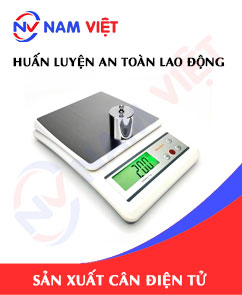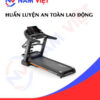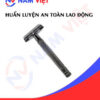Occupational Safety Training in Electronic Scale Manufacturing
99,000 ₫
Note: The above price is calculated for one person, the price may fluctuate depending on the number of trainees participating in the course and depending on market movements. For more accurate pricing support, please refer to the quotation table or contact our consulting staff directly.
Occupational safety is an important issue in electronic scale manufacturing factories and needs to be addressed promptly to ensure the health and safety of workers, and to enhance the reputation of businesses. The Occupational safety training course is one of the effective solutions to raise awareness about accident prevention for workers participating in electronic scale manufacturing.
Table of Contents
Toggle1. Overview of Electronic Scales
a. What is an electronic scale?
An electronic scale is a measuring device that uses electronic sensors to convert the weight force into an electrical signal and calculate the mass based on this signal. Electronic scales are widely used in various fields such as food, healthcare, seafood, industry, maritime, transportation, and other sectors to measure and check the weight of products.

b. Machinery used in electronic scale production
The types of machinery used in the electronic scale production process include:
- Injection molding machines: used to mold the mechanical components of the scale.
- Metal cutting and bending machines: used to cut and bend the metal parts of the scale.
- Welding machines: used to weld the metal components of the scale together.
- Electronic circuit manufacturing machines: used to manufacture the electronic circuits of the scale.
- Assembly machines: used to assemble the parts of the electronic scale.
- Testing and calibration machines: used to test and calibrate electronic scales before releasing them to the market.

c. Electronic scale manufacturers in Vietnam
Currently, there are many electronic scale manufacturers in Vietnam, including well-known brands such as:
- A&D – A Japanese brand producing a wide range of scales from small to large with various features.
- Keli Vietnam – A Chinese electronic scale brand, established in 2001 and present in the Vietnamese market for many years.
- Yamato – A Japanese electronic scale brand producing everything from basic electronic scales to high-precision technical scales.
- Duc Thanh – A Vietnamese electronic scale brand, established in 1993, producing various types of electronic scales.
- Ohaus – An American electronic scale brand, producing a variety of scales with diverse features and high quality.
These brands are reputable and popular in the Vietnamese electronic scale market. However, many other brands also produce quality scales at reasonable prices.
d. Specific jobs in electronic scale manufacturing factories
Group 1
- Chief Executive Officer, Deputy CEO, department heads in the electronic scale manufacturing factory.
Group 2
- Safety officers: manage factory safety, design safety procedures, supervise, and ensure employees comply with safe working practices.
Group 3
- Procurement and data entry: purchase electronic components, sensors, displays, processors, power supplies, control systems, and other auxiliary devices. Enter data and manage warehouse inventory.
- Assembly: attach electronic parts to the scale frame and assemble other components, including mechanical and electronic protection parts.
- Testing and calibration: test and verify the accuracy of the scale, repair, and calibrate necessary components.
- Packing and shipping: pack and label scales, preparing them for delivery to dealers or customers.
- Maintenance and repair: maintain machinery, equipment, and electronic systems and repair faults when needed.
Group 4
- Office work, service, sales, and marketing.
- Production management, quality management, human resources management, material management, finance, and accounting.
- Design and development: create preliminary designs, software for running electronic scales, circuit boards, and other electronic devices.

e. Common types of scales on the market
Scales are a widely used measuring device on the market today. Some common types include:
- Electronic scales: scales that use electronic principles to measure mass accurately and with high resolution. Common applications include industrial, food, healthcare, and household measurement.
- Platform scales: designed as a table to measure larger objects, commonly used in industrial production.
- Analytical balances: used to measure small samples with high precision, typically used in laboratories, chemical, and pharmaceutical industries.
- Hanging scales: designed to hang heavy objects, often used in production and transportation sectors.
- Truck scales: used to measure the weight of goods on trucks and containers.
- Automatic scales: integrated into automated systems, used to measure goods in production, transportation, and storage.
- Mechanical scales: use mechanical principles to measure mass, commonly used in households and retail stores.
2. Overview of Occupational Safety Training for Electronic Scale Production
This article focuses on issues related to Group 3, because Group 3 is directly involved in the production process and faces the highest occupational safety risks. For more information on other groups, see here.
a. What is Group 3 occupational safety training?
- Group 3 occupational safety training consists of sessions that provide awareness on how to prevent workplace accidents for employees.
- This training course helps employees recognize and avoid hazards, reducing the risks of workplace accidents while working.
REGISTER FOR OCCUPATIONAL SAFETY TRAINING SERVICE
b. Training duration
Initial occupational safety training
- Total training duration is at least 24 hours, including examination time.
- 8 hours of theory on policies, laws regarding occupational safety and hygiene
- 8 hours of theory on basic knowledge of occupational safety and hygiene
- 4 hours of theory on specialized training content
- 2 hours of practical training on specialized content
- 2 hours of final theoretical examination
The safety training center will schedule sessions depending on employee availability, usually in 6 sessions over 3 days, provided the company can arrange continuous training time.
Periodic occupational safety training
- Before the occupational safety card expires, employees seeking renewal must attend a periodic occupational safety training, with training duration at least 50% of the initial training duration.
Explanation: the total periodic training duration must be at least 12 hours, including examination time. After completing the periodic training and passing the test, employees will have their occupational safety card renewed.
c. Training content
| No. | TRAINING CONTENT | TRAINING DURATION (HOURS) | |||
| Total | Including | ||||
| Theory | Practice | Examination | |||
| I | Policies, laws on occupational safety and hygiene | 8 | 8 | 0 | 0 |
| 1 | Overview of legal documents regarding occupational safety and hygiene. | 6 | 6 | ||
| 2 | Standards and technical regulations on occupational safety and hygiene. | 1 | 1 | ||
| 3 | Specific regulations from state authorities on occupational safety when constructing, expanding, or renovating production facilities and handling equipment, materials, or substances with strict safety and hygiene requirements. | 1 | 1 | ||
| II | Basic knowledge of occupational safety and hygiene | 8 | 8 | 0 | 0 |
| 1 | Basic knowledge of hazardous and harmful factors in the workplace. | 4 | 4 | ||
| 2 | Methods to improve working conditions. | 1 | 1 | ||
| 3 | Safety culture in production and business. | 1 | 1 | ||
| 4 | Rights and obligations of employers and employees; policies and regimes on occupational safety; functions and duties of safety and hygiene networks. | 1 | 1 | ||
| 5 | Safety rules, signage, use of safety equipment, personal protective equipment; accident first-aid and occupational disease prevention skills. | 1 | 1 | ||
| III | Specialized training content | 6 | 4 | 2 | 0 |
| Comprehensive knowledge of machines, equipment, hazardous substances; analysis, risk assessment, occupational safety management, and safe working procedures for machinery, equipment, and substances with strict safety requirements. | 6 | 4 | 2 | ||
| IV | Final training examination | 2 | 2 | 0 | 0 |
| Total | 24 | 22 | 2 | ||
See more training content of the 6 groups
d. Occupational safety card
After completing the occupational safety training and passing the examination, employees will be issued an occupational safety card (commonly referred to as Group 3 occupational safety certificate).
The Group 3 safety card clearly shows information such as full name, date of birth, job title, and specific working environment. It also includes training duration, red stamp, and signature confirming course completion.
According to regulations on issuing safety cards, as stated in Clause 2 of Article 24 of Decree 44/2016/ND-CP, there are two cases:
- If the employer and employee have a labor contract, the employer must sign, stamp, and validate the Group 3 safety card after the employee completes the training course from the occupational safety training unit and passes the examination.
- If the employee is freelance or seasonal, without a labor contract, the training unit must sign, stamp, and validate the safety card after the employee completes the training and passes the examination.

3. Identifying hazards affecting employees during electronic scale production
Some potential hazards that may affect employees during electronic scale production include:
- Risk of collisions and impacts: During production, components such as sensors, weighing platforms, scale heads, and control devices may be impacted, causing injuries to employees.
- Risk of electric shock: When assembling or maintaining electronic scale components, employees may be exposed to electric shock if safety regulations are not followed.
- Risk of burns or fire/explosion: Chemicals may be used during production for cleaning or protective coating. Handling and using these chemicals may pose burn or fire/explosion risks to employees.
- Noise hazards: Machinery in electronic scale factories may produce high levels of noise, affecting employees’ health.
- Exposure to harmful dust and chemicals: Electronic scale production may generate dust and harmful chemicals if not properly managed and controlled.
4. Common occupational accidents for employees during electronic scale production
Some common occupational accidents during electronic scale production include:
- Impact injuries: Falling or colliding machinery components, materials, or equipment may cause cuts, abrasions, fractures, or other injuries.
- Injuries from machinery use: Operating machines for electronic scale production can cause burns, contact with moving or rotating parts, flying debris from motors, etc.
- Chemical toxicity: Chemicals and additives used in production may cause health issues such as skin irritation, allergies, or respiratory problems.
- Exposure to dust and noise: The production environment may result in respiratory illnesses and hearing loss due to dust and noise.
- Electrical safety hazards: Tasks involving electrical and electronic equipment may cause electrical shocks, burns, or fires.

5. Safety measures when participating in electronic scale production
Some safety measures for electronic scale production include:
- Ensure machinery and equipment are regularly and properly maintained to prevent unexpected incidents.
- Maintain cleanliness and proper ventilation in the factory to prevent fire and explosion accidents.
- Employees must be trained in occupational safety, properly use protective equipment, and comply with safety regulations.
- Ensure employee safety when working with sharp tools, such as knives, scissors, etc.
- Use full personal protective equipment, including masks, gloves, protective jackets, etc.
- Supervise production to detect safety issues early and implement timely solutions.
- Inspect and control the quality of finished products before use.
- Provide clear and complete instructions for use and maintenance to prevent accidents during product use.
- Periodically conduct occupational environment monitoring in factories, collect and analyze harmful factors for employees, and adjust to reduce hazards to prevent occupational diseases.
6. Benefits of occupational safety training for electronic scale production
An Toan Nam Viet provides your company with the following benefits after completing occupational safety training courses according to Decree 44/2016/ND – CP on occupational safety and hygiene for companies and enterprises.
- Employees can identify potential occupational hazards and take preventive measures to avoid accidents.
- Your company can establish risk prevention measures in production, operation, and maintenance processes.
- Reduce costs associated with potential workplace safety incidents.
- Uninterrupted production increases labor productivity and product quality.
- Comply with occupational safety laws and avoid legal risks.
- Enhance credibility and professionalism, thereby strengthening your company’s brand.
Nam Viet’s training courses help individuals prevent external hazards, avoiding injuries or, in severe cases, fatalities.
REGISTER FOR OCCUPATIONAL SAFETY TRAINING SERVICES
7. Customer feedback after completing occupational safety training for electronic scale production
An Toan Nam Viet has many years of experience accompanying numerous businesses across Vietnam, especially in southern provinces. This responsibility is extremely valuable to Nam Viet, which is why its occupational safety training has become increasingly professional. The motivation for Nam Viet’s growth comes from positive feedback and suggestions from companies. Below are feedbacks from partners we have served.
Bac Nam E&C Investment and Construction Joint Stock Company
“My first experience using An Toan Nam Viet’s services surprised me with 24/7 enthusiastic support from the consulting team. Class organization was fast and convenient for our company. Thank you very much for Nam Viet’s service!”
Hoa Dat Construction and Trading Joint Stock Company
“Nam Viet’s services greatly helped us simplify occupational safety and complete safety documentation for work processes. The consulting team was enthusiastic and timely in answering our questions. 5 stars for Nam Viet.”
See more customer interviews after using the services of An Toan Nam Viet
8. Occupational Safety Training Capabilities of An Toan Nam Viet
An Toan Nam Viet is a reputable and high-quality occupational safety training center in Vietnam. Training sessions are continuously conducted at factories, production workshops, or construction sites nationwide (all 63 provinces in Vietnam).
REGISTER FOR OCCUPATIONAL SAFETY TRAINING SERVICES
Occupational Safety Training License
- An Toan Nam Viet has been inspected and certified by the Department of Safety under the Ministry of Labor, War Invalids, and Social Affairs, granting full certification for occupational safety training operations, strengthening our training capabilities.

Training Materials and Lectures
- Before being included in occupational safety training courses, materials are reviewed to ensure accuracy and effectiveness.
- Instructors’ teaching methods are standardized according to An Toan Nam Viet standards, developed by experts in occupational safety and hygiene training to maximize learners’ knowledge retention.
Facilities
- Controlling classroom factors affecting training increases teaching efficiency and learners’ knowledge retention.
- Our training-support facilities provide spacious classrooms meeting standards for area, lighting, and equipment.
9. Nationwide reputable occupational safety training center
At An Toan Nam Viet, we prioritize the professionalism of occupational safety training. Teaching workers self-protection equips them with safety tools for their livelihood, contributing to national development.
To ensure effective training, we carefully prepare every detail—from tools and equipment to curriculum, materials, sound, and lighting.
Our instructors are experienced experts, some with research on hazard identification and prevention across various industries.
Lectures are practical, lively, and easily understood by employees, helping them feel comfortable and retain knowledge. All instruction strictly follows Decree 44/2016/ND-CP.
Employees learn hazard prevention measures and self-protection strategies, applying them appropriately in real work scenarios.
Our training center proudly provides professional and reputable occupational safety training with the following advantages:
- Competitive training costs while ensuring high quality.
- Flexible training schedule according to company production needs.
- Fast certification procedures complying with legal regulations.
- Experienced instructors with long-standing expertise.
- Classrooms control factors affecting training to increase teaching efficiency and knowledge retention.
- Courses tailored to occupational safety practices in enterprises.
- An Toan Nam Viet works diligently and professionally to support clients accurately and promptly.

10. Additional references for occupational safety training in electronic scale production
- Occupational safety materials for electronic scale production
- Occupational safety training material set
- Occupational safety training test set
- Occupational safety training curriculum for electronic scale production
- Occupational safety multiple-choice test for electronic scale production
1 review for Occupational Safety Training in Electronic Scale Manufacturing
No comments yet















namchinh.haiphong341
Dịch vụ huấn luyện an toàn lao động rất tốt nhé, giảng viên dạy rất sinh động dễ hiểu!